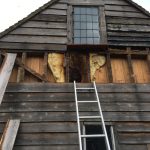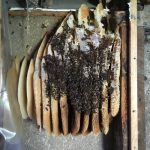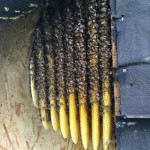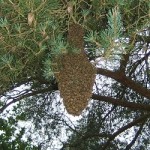Pest control: Bees
Bees
Live bee removal, bees relocated, pest control & bees.
Information on: Honey bees and bee swarms, Bumble bees, Masonry bees (Solitary bees)
Honey Bees.
Free survey, and good advice locally.
Our services provide bee swarm removal, but we also rescue bees from chimneys, wall cavities, trees, attics, loft spaces, walls, air bricks, soffit and fascia boards, and anywhere else they turn up. Bee removal is achieved using a range of techniques depending on the location of the bees.
Honey bees can be left alone unless they are presenting a threat to health and safety or potential structure damage. Bee colony destruction is no longer possible as there is no longer any insecticide approved for bees (As of July 2019). We can advise on the best option for you.
We have developed several very sophisticated techniques for removing honey bee colonies from all sorts of places, including flat roofs and chimneys, often without any dismantling of the structure and without harming the bee colony. Usually these processes, although time consuming, work out substantially cheaper than dismantling, removal of the colony and reinstating the property.
We are at the forefront of bee removal techniques. Unfortunately, its a bandwagon many inexperienced pest controllers have jumped on. Their methods sometimes leave further problems for the property owner which will cost more money to sort out. Some of the methods we come across are totally ineffective, expensive, and sometimes deadly for the bees. We offer the best advice and most cost effective solutions to bees in your house or workplace. Do not be caught out by amateur removal or expensive surveys, our advice and survey is free locally.
If you have honey bees in your property, it’s best to email us with the details and some photographs of where they are getting in. With a little guidance, we can probably asses the problem without a visit. Our online advice is free!
Destroying Bee colonies.
Thankfully, the chemical, Bendiocarb that was approved for use on Honey bees, is no longer approved for that use.
Specific advice-Bees in chimney, what should I do?
Firstly, don’t panic, just call us and we will asses over the phone or by email what is happening.
DO NOT light a fire or spay a can of insect killer up there – either of these actions could bring a mass of bees suddenly into the room at the very least. Advice is free, use it!
Bee swarms
Sometimes you will get bees turning up in huge numbers, usually in April, May or June. This will be a honey bee swarm. Here is a video of a swarm in Farnham, Surrey last year.
Bee Swarm information
1) Do not panic, the bees are not angry. Calmly close windows and doors and stay indoors, the swarm may pass over you in a big cloud. If the odd bee lands on you, do not swat it, let it move off or carefully brush it off.
2) If the bees start to settle then call us now and we will remove them for you. Never attempt to kill or disturb them.
If the bees are honey bees, and they have formed the swarm into a clump of bees in the garden or on your property, we can remove this for you. A bee swarm may land anywhere, but frequently they are low down in a bush or fence. Wherever the bees land, we will do our best to remove it for you before it has the chance to cause any problem. There is the possibility that the swarm will alight on your property and set up home there if suitable, which can prove to be expensive. Far better to have it removed to another area where it will not cause problems. We can attend sooner than most, please call us for the fastest service to remove bee swarms. We do charge for this service.
Bumble Bees
These bees do not normally cause problems unless they choose to make a nest which is too close for comfort. Bumble bees will attack and do sting if they think the nest is threatened. For this reason, they may need to be removed. Bumble bees can be relocated if the core of the nest is accessible. Last year we carried out many removal and relocations. Please call to discuss your bee issues.
Solitary bees, Mason bees
These bees are harmless and are present for very shot periods of time. They sometimes congregate in areas which can make them look like wasps or honey bees.
Identifying bees and wasps
The beginning of summer marks the arrival of insects, sometimes in considerable numbers. Most of these go un-noticed, but bees, wasps and ants sometimes cause alarm when they create their home in close proximity to ours. There is some difficulty in correctly identifying the difference between wasps and the many species of bee.
Please make a note of your observations of the following;
The rough date you first noticed the insects.
Are they round and hairy, or torpedo shaped?
Have they formed a clump, possibly hanging from a tree, shrub or fence?
What colour are they?
Do they have distinctive markings, such as a white tail?
Approximately how high up are they?
Are they going into individual tiles or holes in brickwork or air bricks?
Are they going into small holes in the ground?
Are they bobbing up and down or side to side outside of their entrance hole?
Are they purposefully coming and going?
Are they going into one hole at ground level?
How many do you see around the entrance to their nest?
Can you hear a humming or chirping in the ceiling at night?
Is there a stain, mould or smell of honey where you think the bees are?
If you can answer most of these questions, we may well be able to answer your queries over the phone.




